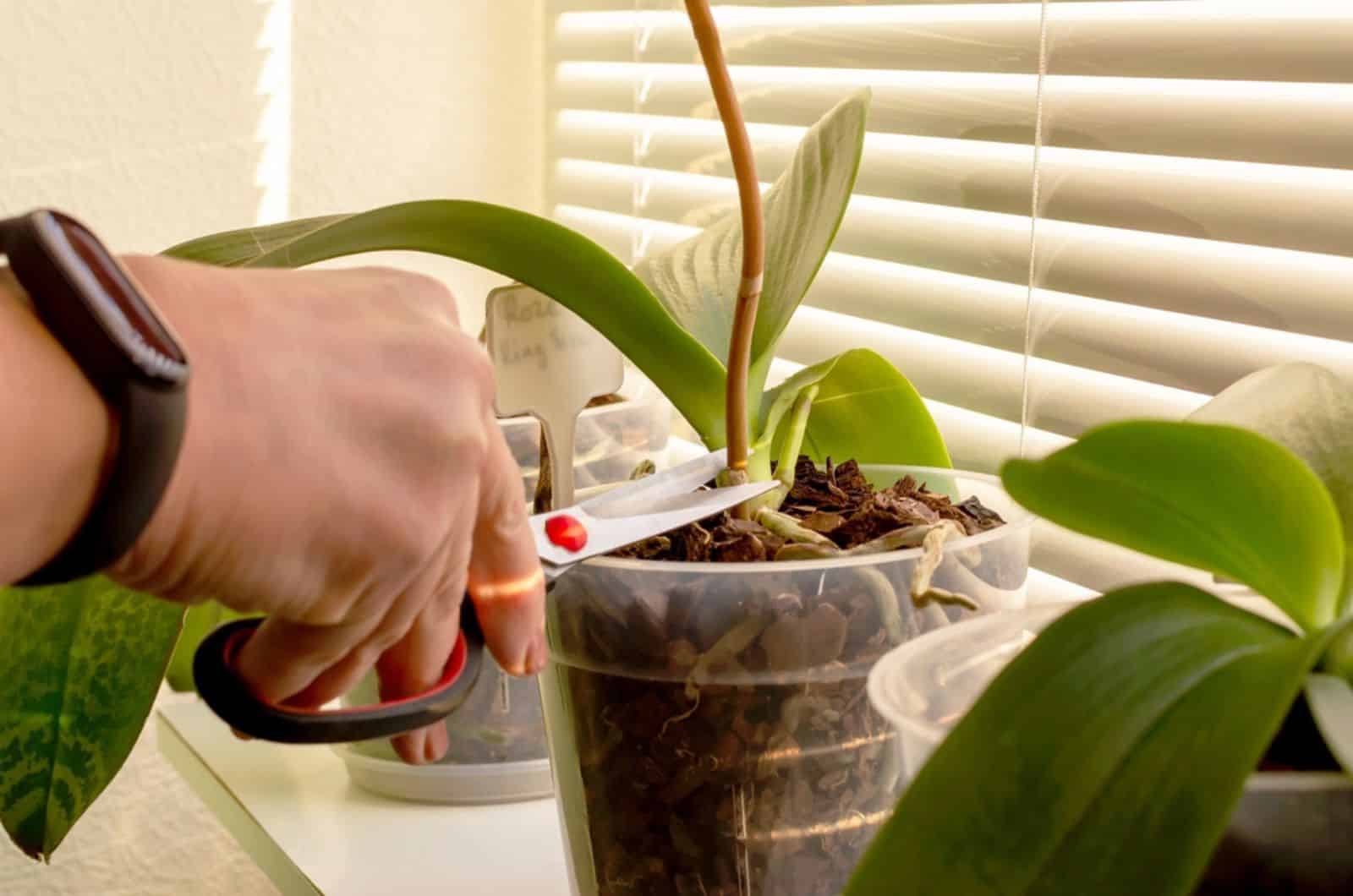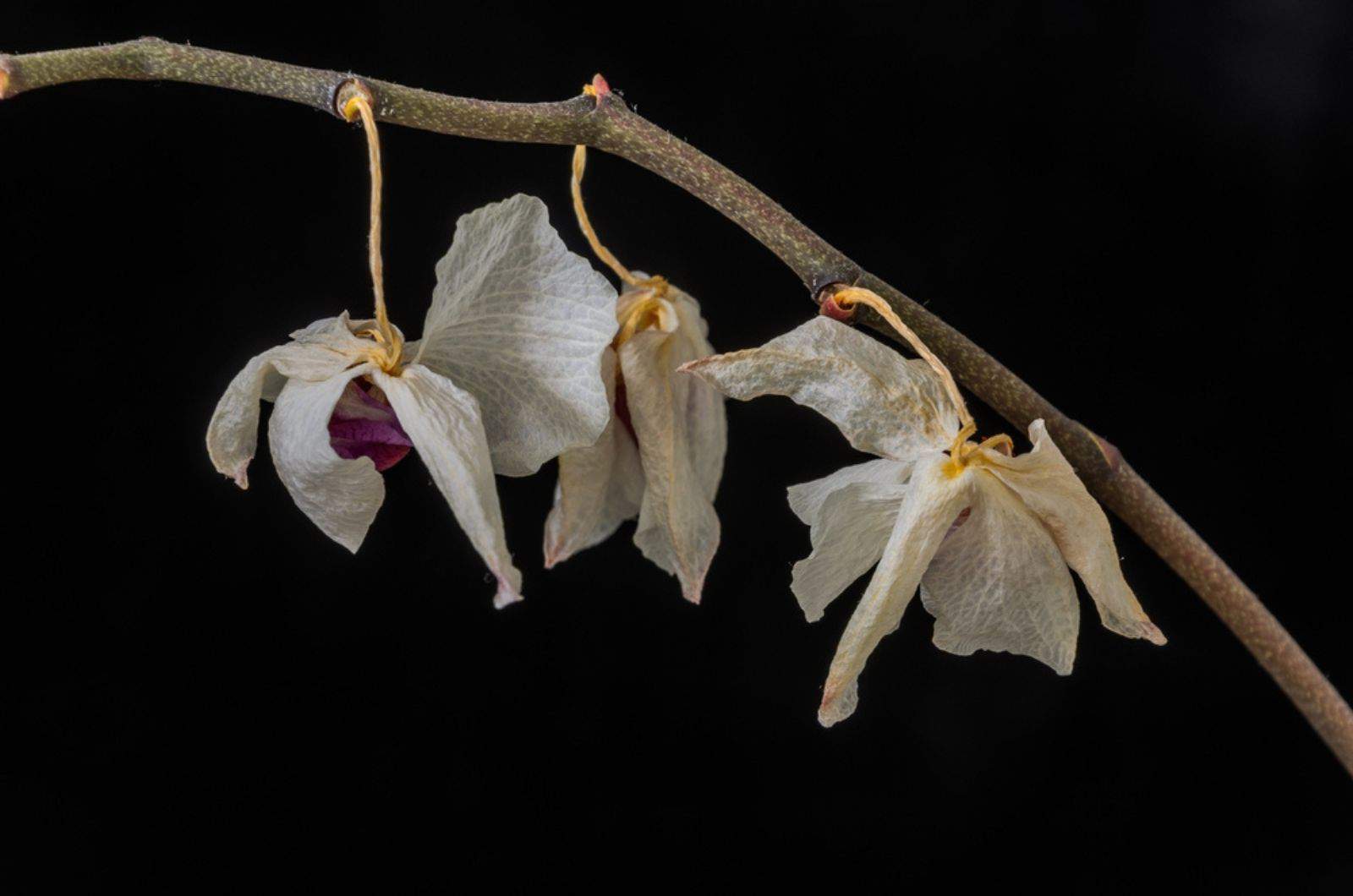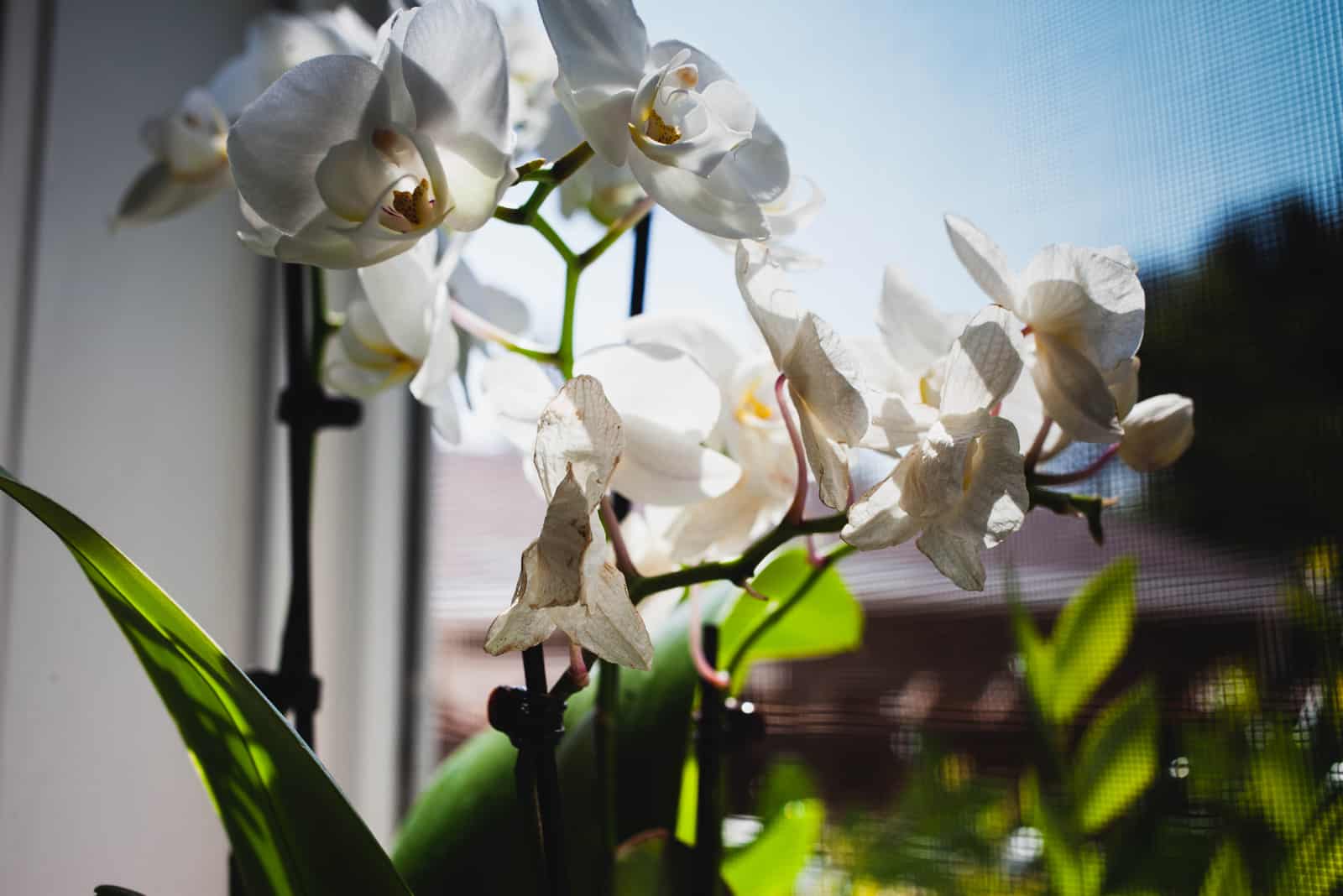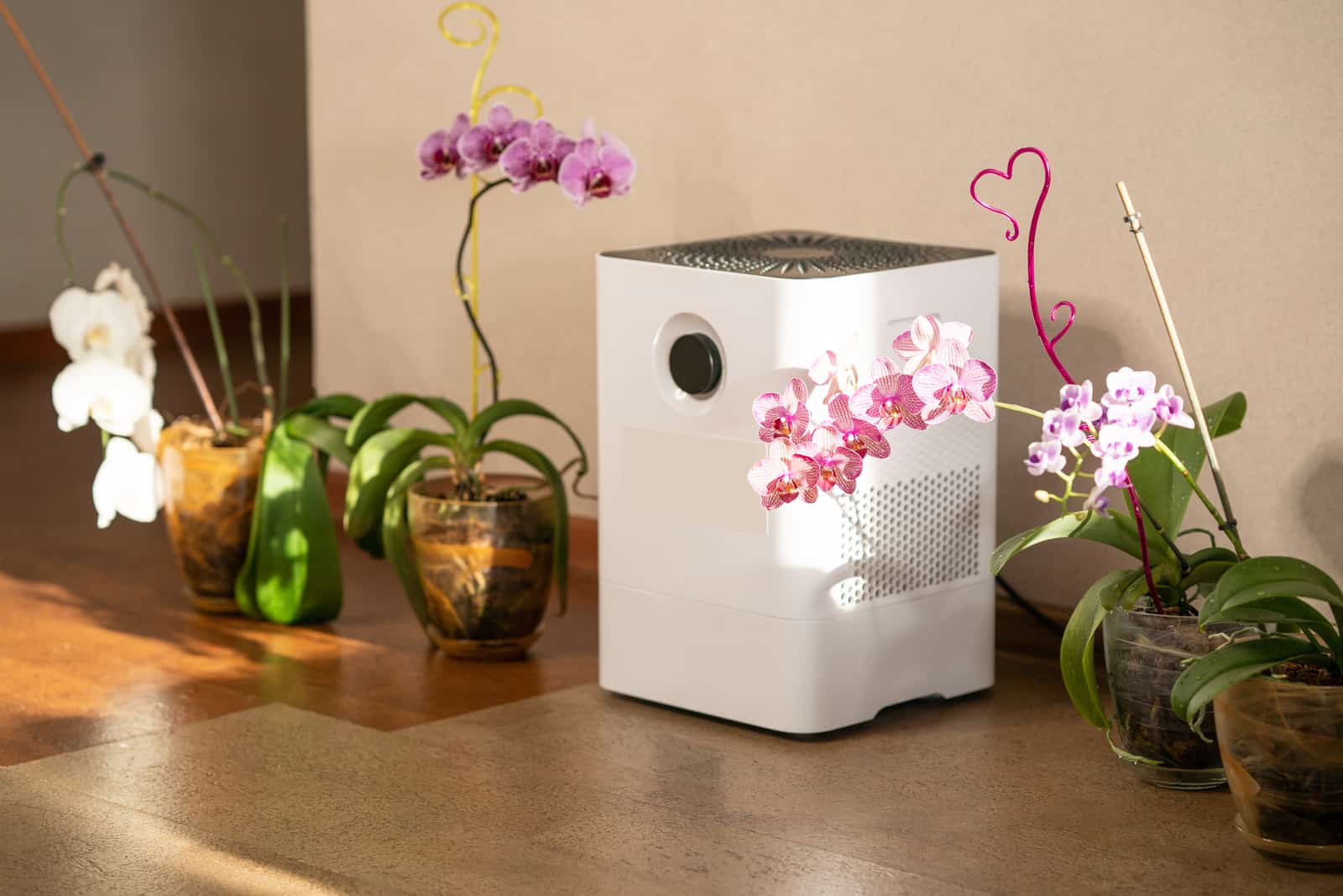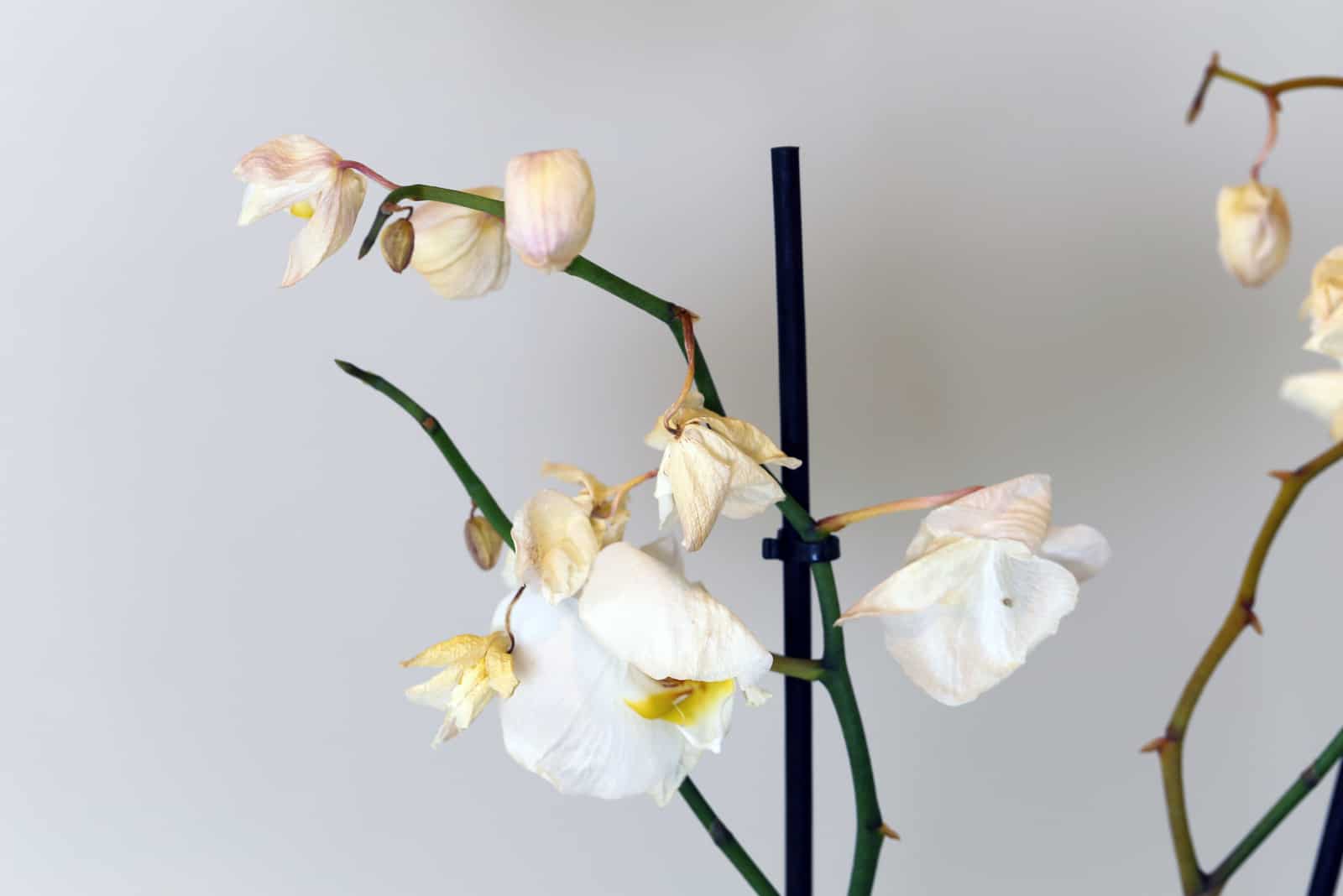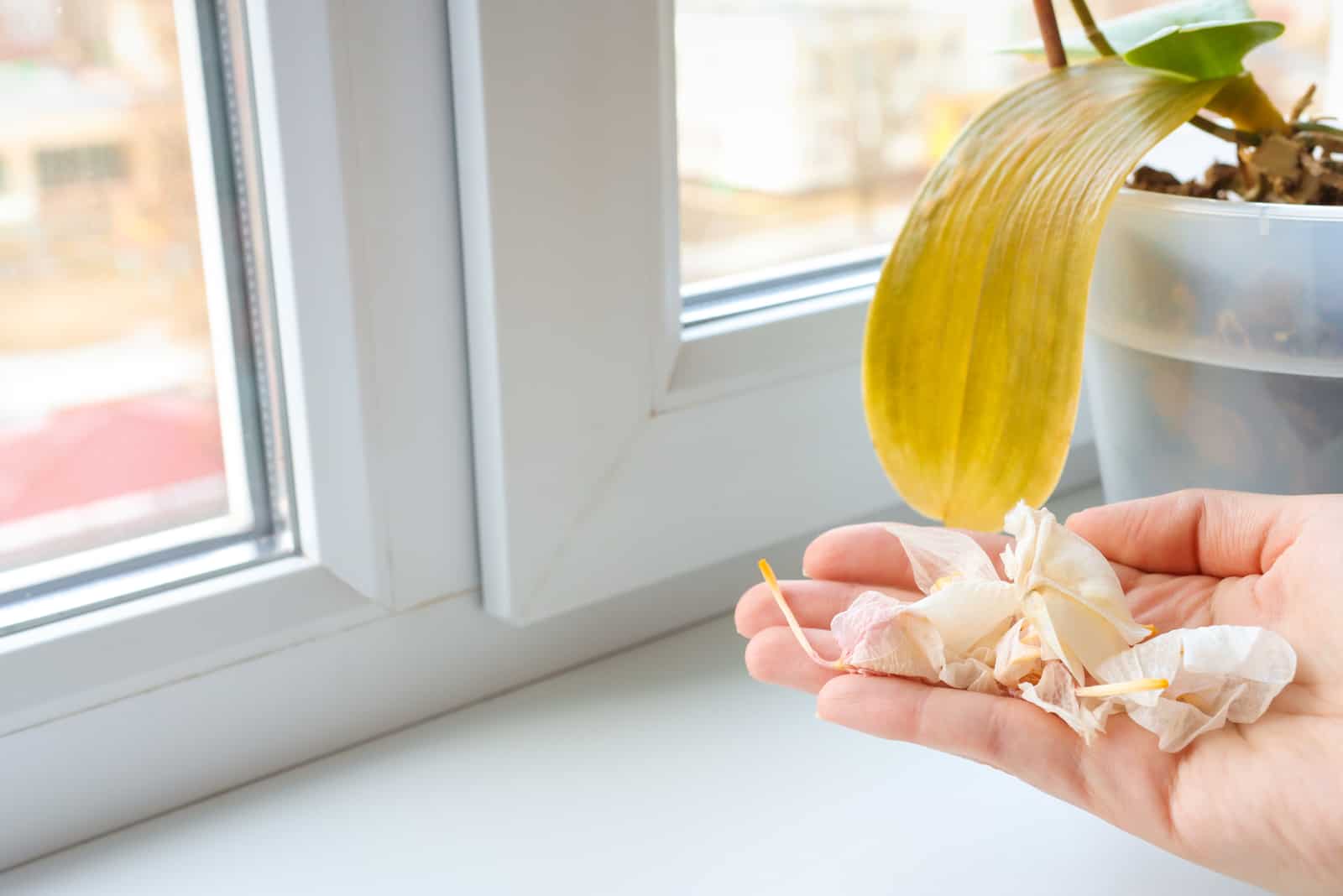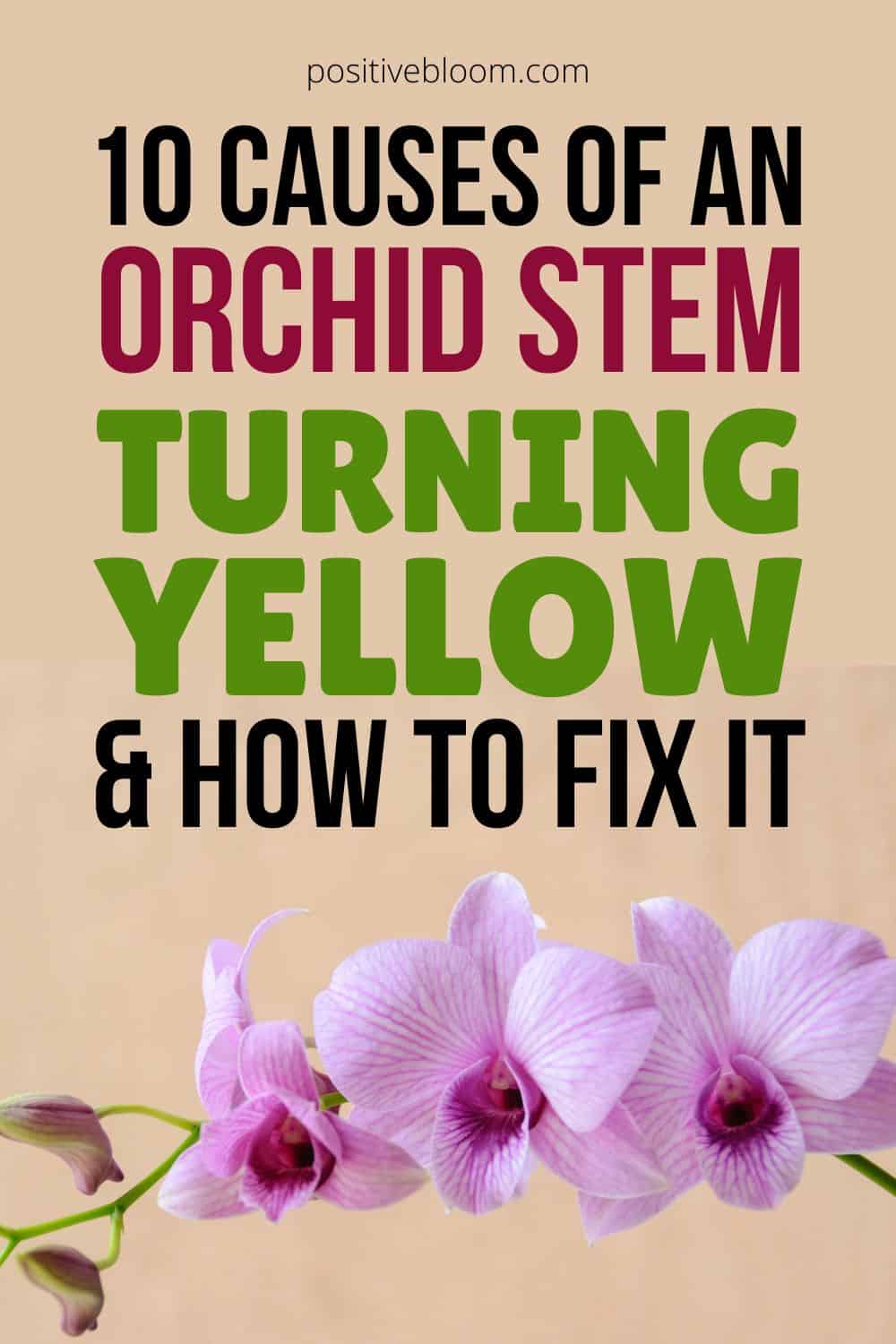If you notice your orchid stem turning yellow, it is not only an unsightly issue, but it may also be hiding many other underlying problems that can kill your plant if left untreated.
Therefore, it is essential to figure out why your orchid’s stems are changing color and what you can do to fix it.
Thankfully, many of these issues can be prevented with appropriate care, so you won’t have to deal with them if you properly tend to your plant’s needs.
Of course, we all forget to water our orchid plant from time to time (or forget we have already irrigated it and then give it more moisture than it needs) or keep it in a spot where direct sunlight can burn its delicate leaves.
Check out the article below to learn the ten most common reasons your orchid stems are turning yellow and how to deal with them.
10 Causes Of An Orchid Stem Turning Yellow And Their Solutions
Common reasons your orchid is dying or turning yellow are quite similar. They include inadequate watering, lack of humidity, not enough light, nutrient deficiency, and pests.
However, yellowing of the orchid stem can be a natural occurrence, so it doesn’t necessarily indicate that something’s wrong with your plant.
Regardless, we’ll still examine the most common causes of yellow orchid stems and how to deal with them before it’s too late!
1. End Of A Blooming Cycle
All plants age, and during that process, it’s only natural that their color and appearance will change. Therefore, there’s no reason to press the panic button if you notice the top part of the stem turning yellow.
The blooming cycle uses much of the plant’s energy, and the stems turn yellow (or brown) and then die.
Technically, there isn’t a solution to old age, but there is something you can do. Remove the dried and dead cells after blooming so that the plant can direct all its energy and resources to the development of new roots and new stems that will bear orchid flowers.
Generally speaking, flower spikes will dry and drop on their own, but why wait and waste energy that could be used elsewhere? Dried stems won’t rebloom, and removing them will make space for the new flower spikes that will bear attractive blossoms.
2. Overwatering
Too much water and careless irrigation can lead to root rot and fungal infections that will spread to your plant’s stems and leaves if left untreated.
Wet and warm environments are perfect for fungi, so it’s not surprising that overwatered plants catch fungal crown rot and root rot.
You can easily recognize the symptoms of these diseases by the droopy appearance of your plant, mushy, soggy, or yellow leaves, dripping soil, stunted growth, and a rotting stench coming from the pot.
Thankfully, there are ways you can deal with or prevent these issues, and you can read more about them in the following paragraphs.
Solution To Overwatering
If you suspect that your plant is overwatered, stop irrigation until the mix partly dries and then continue watering your orchid once or twice a week. You can also repot your plant immediately into fresh soil and adjust watering.
If you notice that your plant has been looking down for quite some time and has stopped growing, you should take it out of its pot and inspect the roots.
If they are mushy, dark, and soggy, you should remove them with sterilized shears, spray them with a broad-spectrum fungicide, and place your plant in a fresh orchid mix and a new container.
Fungal crown rot is dealt with in a similar way; remove the infected parts and spray them with a fungicide.
Orchids are found on the list of best plants for LECA, so you can transfer them into a see-through vessel filled with LECA clay pebbles and water.
Before transferring, ensure you remove all the dirt from the roots you can and continue cleaning the roots once a month until they are completely bright green.
You’ll have to irrigate your plant less, but don’t forget to feed it with a hydroponics fertilizer whenever you replenish the water.
3. Underwatering
Orchid roots and stems are pretty resilient, and even though they prefer dryness to water-clogged soils, that still doesn’t mean you shouldn’t irrigate them for weeks on end.
Orchid leaves will start to curl, turn yellow, and fall off because the plant will shed its glorious foliage so that it loses less water via transpiration.
But if there is no foliage, how will the plant photosynthesize and produce the food and energy it needs for healthy growth?
That’s the problem; it won’t. The entire plant will start to turn yellow and brown, droop, and slowly fade away if you don’t give it enough water.
Lack of moisture can also make it difficult for the plant to absorb the necessary nutrients and minerals, only leading to more issues.
Solution To Underwatering
Thankfully, fixing this problem is simple. All you’ve got to do is water your plant!
But you cannot get away with watering your plant once and then going back to old habits.
Be consistent, and irrigate your orchid plant at least once a week or whenever you notice that the top few inches of the soil are dry.
Keep adding more water until you notice it has started to drain out through the potholes. Let the water seep through them into the tray, and empty it once the soil drains entirely.
4. High Toxin Levels
Frequent fertilization, chlorine, fluoride build-up, and the presence of excessive amounts of ethylene gas in the air can lead to high toxin levels, which can turn the entire orchid (stems and all) yellow and even kill it if neglected.
For instance, orchids benefit from occasional feeding, but too many nutrients in the soil can be detrimental and hinder your plant’s ability to uptake water.
Chloride and fluoride poisoning usually occur due to using tap water for irrigation, and it is even more dangerous and evident if you grow your plants in LECA pebbles.
You can recognize overfertilization and chlorine and fluoride build-up by examining the surface of the potting media, be it an orchid mix or LECA. Tiny, shiny, crystal-like structures will appear on the surface of the substrate and are a bad sign.
Finally, ethylene gas. Even though it is highly unlikely that there is enough of this gas in your household to hurt your plants, it is still possible. For instance, ethylene is used in heating, and if the pipes are damaged, it can leak into the air you breathe.
This is very serious for your overall health, not just the plant’s, so you should fix the leak as soon as you notice it.
Thankfully, orchids are slow growers and will exhibit the symptoms of ethylene poisoning only after prolonged exposure to this gas.
Solution To High Toxin Levels
Most orchids grown as indoor plants are phalaenopsis orchids, which are perfect for beginners as they don’t require too much care.
That’s why we tend to overfertilize them and create issues ourselves. Well, the key to avoiding overfertilization and fertilizer burn is feeding your plants with orchid food or a regular houseplant fertilizer diluted to half or quarter-strength every other week.
If you have already overfertilized your plants, you can simply repot them or flush the soil by slowly pouring in water and allowing it to drain through the drainage holes.
Your plant might also suffer from chlorine and fluoride build-up, and in that case, you should research what the best water for plants is (distilled water is a great option here) or let the tap water sit in the air for approximately 24 hours so that the chlorine can evaporate.
When it comes to ethylene toxicity, there are products that block the reception of this gas, so you can try those. Essentially, the best way to deal with this issue is to check your heating regularly and protect yourself and your plants.
5. Lack Of Humidity
Orchids are tropical plants, which means they need high air moisture levels to thrive. However, the relative humidity of the average household is around 40%, which isn’t enough for these mist-loving plants.
Certain parts of the plant, such as the leaf tips and aerial roots (only the monopodial type of orchids have aerial roots, not sympodial, which are more common as houseplants), will turn brown, curl, and die if the moisture level doesn’t change.
If the humidity levels aren’t increased, other parts of your plant will experience color changes, such as stems and blooms. Orchid flower spikes will start dying, and the blossoms will fall off.
But there are a couple of things you can do to raise humidity if you live in drier climates, and we’ll discuss them in the following paragraphs:
Solution To A Lack Of Humidity
There are a couple of things you can do to raise indoor air moisture levels for proper orchid care.
For instance, you can simply mist these plants from time to time or get a humidifier to do the heavy lifting for you.
Some recommend using pebble trays, but there are doubts about their effectiveness. These humidity trays raise the air moisture level by 7%, but it can reach only the bottommost leaves before dispersing.
Grouping your plants is not the best solution to low humidity as there won’t be a significant increase, and your plants will still be dehydrated.
Therefore, stick to misting and humidifiers if you live in arid climates.
6. Too Much Light
In orchid plant care, you’ll usually read that they need indirect light in order to thrive because too much sunlight can burn your colorful friend and leave it with yellow-to-brown leaves and stems.
Direct light can lead to other issues, such as droopiness, stunted growth, and loss of color. The stems of some varieties, such as Phalaenopsis orchid, will turn red, but don’t enjoy this color too much as it’s a sign that something is not right with your plant!
Always check the type of orchid you have because Cattleya orchids, for instance, will have red stems if they get enough sunlight.
Solution To Too Much Light
There are a couple of simple solutions you can implement to get a healthy orchid back. One of the first things you should do if you notice that your plant has suffered sunburn is to move it to a more shaded area.
However, these plants cannot thrive in complete darkness, and if your only two options are direct light and shade, you should consider getting some artificial lights.
However, even grow lights can burn plants, or rather the heat they emit may burn them, so consider getting some LED lights or placing the lamp a few feet away from your orchid.
Unfortunately, the damage done by the sun cannot be reversed, so you’ll have to prune the burnt parts to make room for new leaves and stems.
7. Temperature Fluctuations
Sudden temperature swings can cause many issues, such as flower drop, droopiness, and stem color change.
Therefore, you have to be very careful about the placement of your indoor plant and prepare to move it in advance.
It is best to avoid this issue in the first place as it can lead to bud blast – premature dropping of the flower buds before or immediately after opening.
We all want to admire the orchid’s flowers, not its leaves or stems, although they are a nice addition!
Solution To Temperature Fluctuations
One of the things you can do to prevent sudden temperature changes is to keep your plant away from spaces where it is likely to happen, such as AC vents, heaters, drafty windows, etc.
These places usually have lower humidity levels due to increased air circulation, so your plant will face multiple issues if kept there.
Also, if you need to move your plant or send it to someone during winter, put a heat pack in the box to do everything you can to avoid stressing your plant unnecessarily.
Orchids prefer warm temperatures, so ensure they are between 65-80°F in the daytime and 60-70°F at night.
8. Nutrient Deficiency
Most plants benefit from additional feeding, and the same goes for orchids, mainly because their potting medium doesn’t necessarily have to be rich in nutrients and organic matter.
But, if we forget to fertilize our plants, they will show us their suffering through discolored foliage and stems, droopiness, stunted growth, etc.
Thankfully, the solution to this issue is relatively simple, and all you need to do is feed your orchids more often, right?
Well, not exactly! You first have to determine which nutrient the plant lacks.
Lack of nitrogen is the most common cause of yellow stems, so you should replenish this mineral as soon as you establish that it’s causing your orchid’s stem to turn yellow.
Of course, you should get a soil test before adding more fertilizer, just to be sure that your plant truly needs more nitrogen.
Furthermore, lack of water can also lead to nutrient deficiency as well as fertilizer burn. The plant won’t be able to absorb the nutrients in the soil, and the additional food will only burn the orchid’s roots.
Solution To Nutrient Deficiency
One thing I love about orchids is that they thrive in slightly acidic soils, so watering these plants with tea can be beneficial.
This will add some minerals your plant needs and prevent total nutrient deficiency, while lowering the pH of the substrate at the same time.
However, you shouldn’t water your plants with tea every time because it can make the soil too acidic and prevent the absorption of nutrients.
Once you determine that your plant truly needs more nitrogen, find a fertilizer rich in it and add it a few times. Once you notice that the plant is getting better, you can switch to a regular orchid plant food because too much nitrogen will reduce flowering.
Fertilize your orchids twice a month or feed them every time you water them, just make sure to dilute the fertilizer to a quarter-strength or more if you use a stronger one.
Only feed these plants during their growing season because fertilizing them in dormancy can do more harm than good.
Orchids enter a resting phase in winter and cannot use the nutrients you give them, so there’s no point in adding more food, which would only hurt them.
Also, remember to water the plants before feeding them to make the replenished minerals available.
9. Pest Infestations
Believe it or not, not all insects are bad for your plants. There are also beneficial pests such as soil mites that play an important role in decomposition and help your plants thrive.
They even eat spider mites, which are a real nuisance!
However, some pests, such as mealybugs, spider mites, and aphids, drink your plant’s sap and can make it droop, lead to the orchid’s stem turning yellow, and even cause the death of the plant if left untreated.
However, there are many different ways you can deal with pest infestations, both organic and chemical, and we’ll discuss some of them in the sections below.
Solution To Pest Infestations
One of my favorite organic ways of dealing with pests is introducing some ladybugs to eat these nuisances. However, if you’re not a fan of bugs and insects moving around your home, there are other things you can do.
For instance, if the infestation is not significant, you can always use a cotton swab dipped in rubbing alcohol or neem oil to get rid of pests.
However, larger swarms of mites and mealybugs cannot be removed efficiently or easily that way.
You can try placing the plant under a faucet of slow-running water to try and get rid of the bugs.
I know many of you won’t like to hear it, but you might have to use pesticides to exterminate harmful insects before they kill your plant.
I know it’s not organic, but it works, and it won’t harm your plant if you follow the instructions on the package.
10. Orchid Stem Turning Yellow After Cutting
Yellowing of the orchid stem after cutting either leaves or entire stems is quite common as there are fewer leaves that can photosynthesize.
Without enough food and energy, the plant needs to redistribute resources to the parts that need them the most: the roots.
They will send new growth that produces young leaves, and the plant’s new stems will be healthy as ever.
But that doesn’t mean you should hang up your pruners and stop trimming altogether. Dry, dead, or diseased parts of the plant should be removed as they only waste energy and take up space that could be filled with healthy leaves and stems.
Solution To Orchid Stem Turning Yellow After Cutting
The most important thing about pruning any plant, not just orchids, is never removing more than 1/3 of the entire plant.
If you cut away almost all the leaves, there won’t be enough left for photosynthesis, and your plant will suffer.
Frequently Asked Questions
We talked about the orchid stem turning yellow, but if it changes its color to brown or black, what then? Are the causes and solutions the same?
Find out below!
What do I do if my orchid stem turns brown?
If your orchid stem turns brown, you should prune it just above the node to encourage branching and reblooming if the lower part of the stem is healthy.
However, if the entire stalk is brown, you should cut it at the plant’s base so that new, healthy growth can take its place.
Orchid stems usually turn brown for the same reasons they turn yellow, but the most common one is definitely the natural aging process.
Still, you should make sure to take good care of your plant, give it enough water, light, and nutrients, and it will thrive.
What caused the stem of my orchid to turn black?
The orchid stem will turn black because of root rot if it’s advanced, which is a serious condition.
You should try to remove the diseased parts, apply fungicides, and repot the plant into a pot filled with fresh soil.
Unfortunately, stem rot is hard to cure and not always successful, so you should look for healthy bulbs or offshoots to propagate.
Final Word
This article discussed the most common reasons for an orchid stem turning yellow. Even though some of them occur naturally as a result of the aging process or pruning, most of them are caused by inadequate care.
You can help prevent it by exposing your plant to indirect light, watering it only when the top few inches of the soil are dry, and feeding it twice a month.
The type of water you use is also important because tap water can cause chlorine and fluoride build-up, which may hurt your plant.
Hopefully, your orchid will be healthy and thriving in no time!
Until next time!
Like This Post? Share Or Pin It For Later!

